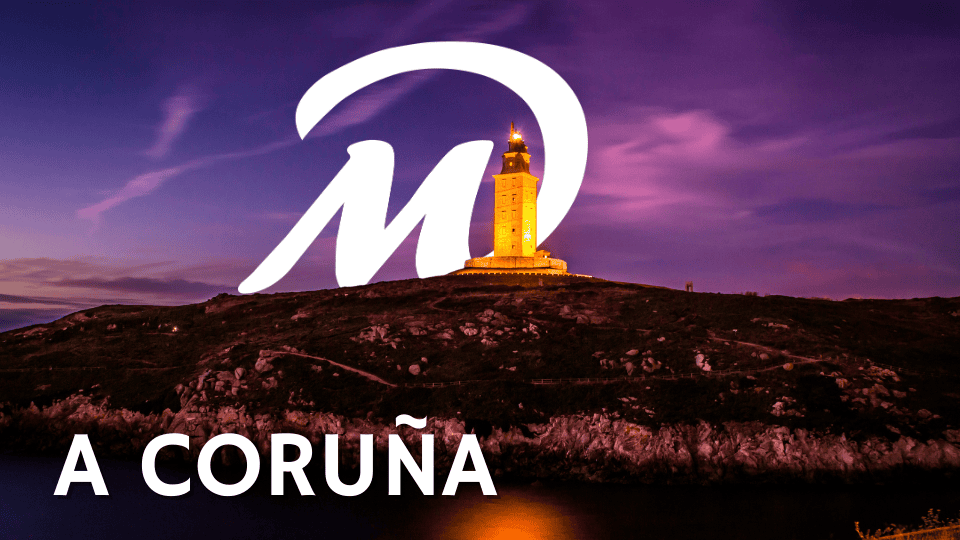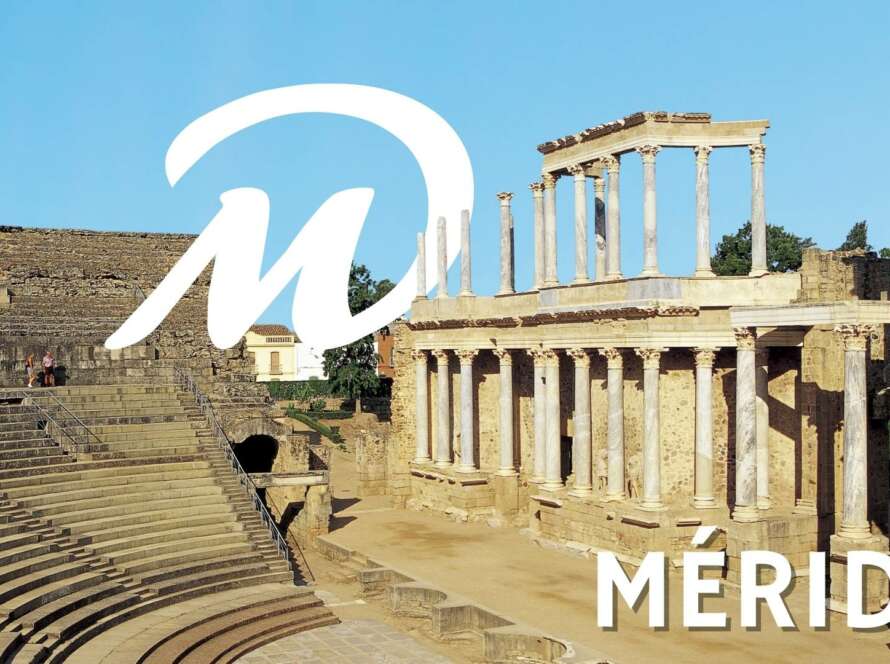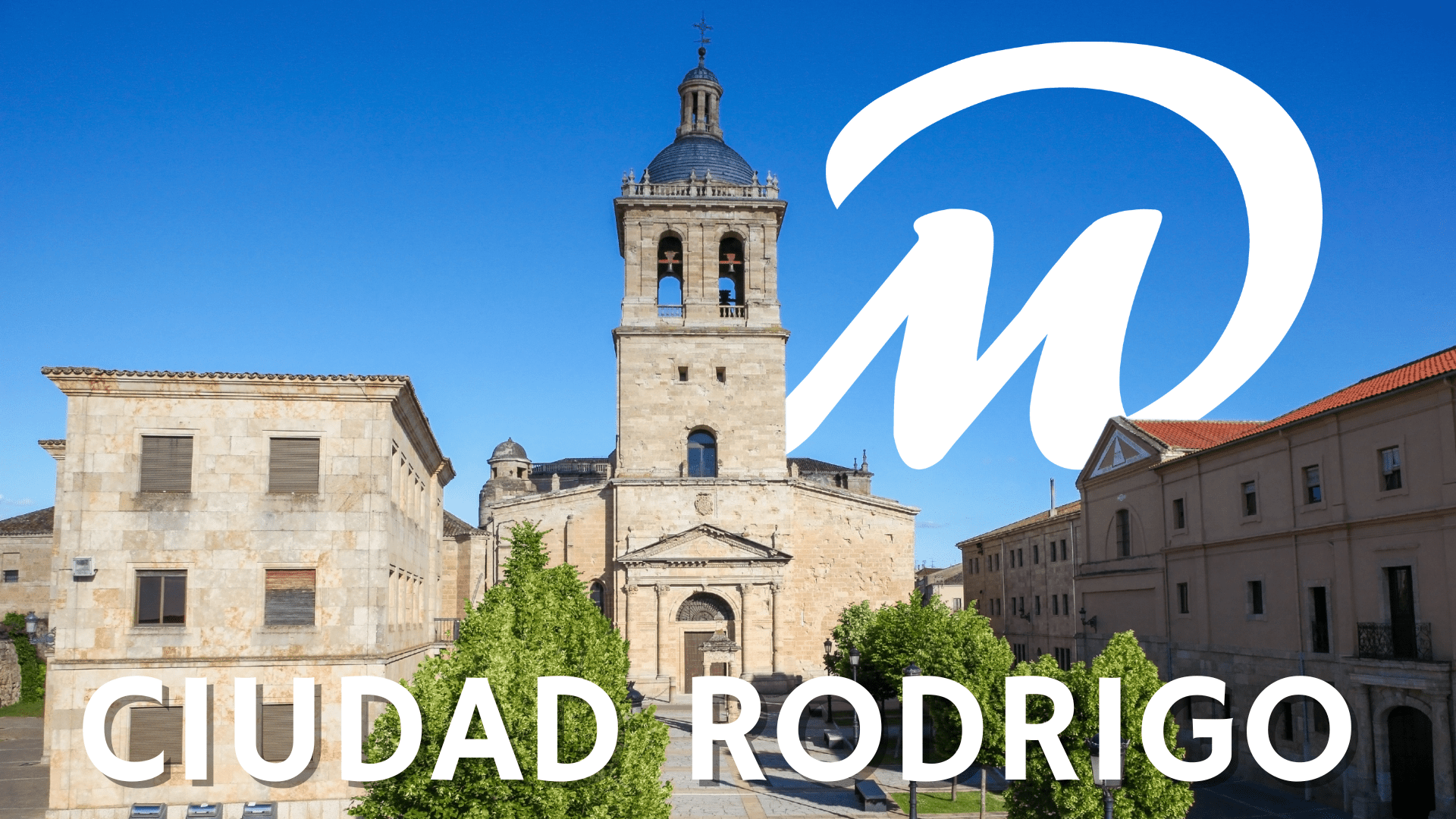If you’re planning your next European adventure, you can’t leave Dublin off your list. Known as the literary city and the birthplace of great writers, Dublin is not only a cultural destination, but also a vibrant city full of history, art and a unique energy. In this post, we tell you things to do in Dublin, from iconic monuments to secret corners that will make your visit unforgettable – get ready to immerse yourself in all that this wonderful city has to offer!
Dublin is a city that seamlessly blends tradition and modernity. From its historic streets to its vibrant pubs, stunning parks to its famous museums, every corner of the city has a story to tell. If you’re a lover of literature, Dublin will be your paradise, with its rich literary heritage ranging from James Joyce to Samuel Beckett. But the city is not just about culture: its secret corners, delicious food and welcoming atmosphere invite you to explore unhurriedly. In this post, we guide you through the best of the city of the literature and help you discover Things to do in Dublin to make the most of your visit.
Table of Contents
Things to do in Dublin. 10 must-see stops.
Saint Patrick’s Cathedral.

Saint Patrick’s Cathedral, the largest in Ireland, is a must if you are wondering things to do in Dublin. Founded in the 12th century, this imposing Gothic cathedral is dedicated to St Patrick, the patron saint of Ireland. Its architecture is impressive, with high ceilings, Gothic columns and beautiful stained glass windows decorating the walls.
A fascinating aspect is its literary connection, as Jonathan Swift, author of Gulliver’s Travels, was dean here in the 18th century. His tomb is located inside the cathedral, making it an important place for literature lovers. Also of note inside is the monumental organ, one of the largest and best preserved in Ireland, which can be heard at regular concerts.
St Patrick’s Cathedral is impressive not only for its size and architecture, but also for St Patrick’s Gardens, a green space where you can stroll and relax. The Visitor Centre offers an interactive exhibition on the history of the cathedral, its importance in Irish culture and its influence over the centuries. A key place to understand the history of Dublin and Ireland.
Christ Church Cathedral
Christ Church Cathedral is another must-see in Dublin and one of the oldest churches in the city. Founded in 1030, this medieval cathedral has a fascinating history that makes it a key point in Ireland’s religious history. Originally built by the Vikings, it has been remodelled and enlarged over the centuries, combining Gothic and Norman elements in its architecture. Its impressive façade, with a majestic soaring central tower, is just the beginning of what you’ll discover here.
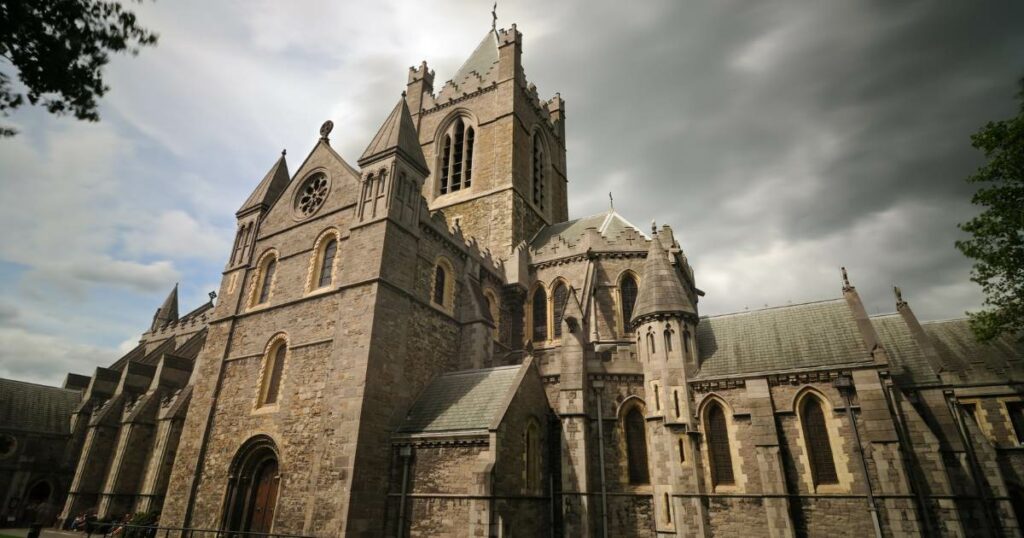
As you enter, you will be greeted by a solemn atmosphere, where architectural details such as the beautiful arches and stained glass windows adorning the walls stand out. Christ Church’s organ is one of the oldest and most famous in Ireland, and its sound resonates during the concerts and services that are regularly held in the cathedral.
An interesting aspect of the cathedral is its crypt, the largest in Ireland, which houses an impressive collection of historical artefacts, from religious vestments to medieval artefacts. The crypt has also served over the centuries as a storage place for church artefacts and is a fascinating place to explore.
Christ Church Cathedral also has a connection to medieval Dublin, as it was the seat of the archbishops of Dublin for centuries. Inside, as well as the religious elements, there is also a museum which tells the story of the cathedral and its role in the life of the city over the years.
If you’re wondering things to do in Dublin, Christ Church Cathedral is definitely a key point that combines history, architecture and art.
The Castle
Dublin Castle is one of the city’s most iconic landmarks and an essential stop if you’re wondering things to do in Dublin. This imposing castle, which dates back to the 13th century, was originally built as a Norman fortress and played a key role in Irish history, serving as the residence of English viceroys for centuries. Over the years, the castle has witnessed numerous historic events, including the signing of Ireland’s independence in 1921.

Today, Dublin Castle is a complex that houses various governmental and cultural institutions. Its architecture combines medieval elements with Georgian structures, making it a fascinating blend of styles. As you walk around the castle, you can admire its impressive ramparts, defensive towers, and courtyards where important ceremonies were once held.
One of the highlights of the castle is the Chapel Royal, a richly decorated chapel with impressive acoustics, which often hosts concerts and religious events. In addition, the Throne Room, a historic place where official ceremonies were held, will take you back in time and give you a glimpse of the castle’s former splendour.
Further into the grounds, you can explore the Castle Gardens, a tranquil space for strolling, and the Castle Museum, which offers interactive exhibits on the history of this iconic landmark and its evolution over the centuries.
In short, Dublin Castle is a place that is not only architecturally impressive, but also deeply linked to the history of Ireland. If you’re wondering things to do in Dublin, this castle is a key point to immerse yourself in the city’s rich heritage.
Temple Bar
Temple Bar is one of Dublin’s most iconic neighbourhoods and one of the top tourist areas not to be missed if you’re wondering things to do in Dublin. Known for its vibrant atmosphere and nightlife, Temple Bar is the heart of entertainment and culture in the city. Its cobbled streets are lined with traditional pubs, live music bars, art galleries and restaurants, creating a unique atmosphere that attracts locals and tourists alike.
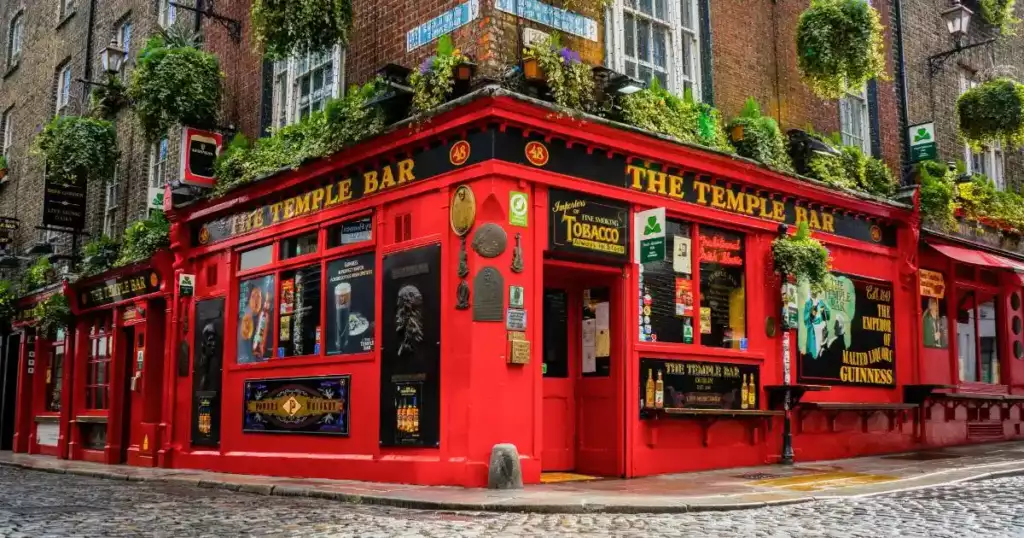
As well as being famous for its nightlife, Temple Bar is a place steeped in history. Its streets are lined with restored buildings dating back centuries, with colourful facades that contrast with the modern shops and cafes that have sprung up in the area. The neighbourhood is also home to some of Dublin’s most important cultural institutions, such as the Temple Bar Cultural Centre, which offers a programme of contemporary art, film and music.
One of Temple Bar’ s most iconic venues is the Temple Bar Pub, a traditional pub that has been a landmark in the city for years. With its traditional décor, wooden tables and cosy atmosphere, this is a great place to enjoy a pint of Guinness or an Irish whiskey. You can also enjoy live music, a typical feature of pubs in this area.
If you like culture, don’t forget to visit the Temple Bar Market (open on Saturdays), which sells local produce, from artisan food to handmade crafts. It’s a great place to take home a unique souvenir of the city.
In short, Temple Bar is the perfect place to immerse yourself in the true spirit of Dublin, with its mix of history, culture, music and nightlife. If you’re wondering things to do in Dublin, this neighbourhood offers a complete experience that reflects the essence of the city.
O’Connell Bridge
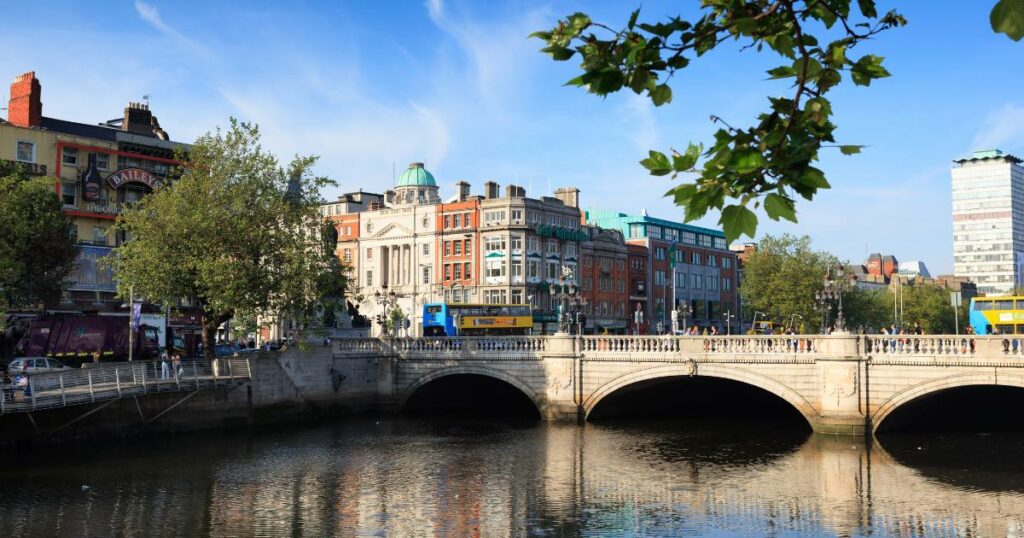
O’Connell Bridge is one of Dublin’s most iconic landmarks and an essential stop if you’re wondering things to do in Dublin. Opened in 1794, this historic bridge, originally known as Carlisle Bridge, was designed by architect James Gandon. In 1882, it was renamed in honour of Daniel O’Connell, a prominent Irish nationalist leader, and today his statue stands at the north end of the bridge.
One of the most striking features is its unique design. It is one of the few bridges in Europe whose width (50 metres) is greater than its length (45 metres), giving it an almost square shape. Built of granite and Portland stone, the bridge stands out for its solidity and beauty, making it an architectural icon of the city. The cast-iron chandeliers, restored in 2004, add a classic and romantic touch to its structure, making it a perfect place to pause and enjoy the cityscape.
O’Connell Bridge connects the north of Dublin, via O’Connell Street, to the south of the city, where key commercial and cultural areas such as Westmoreland Street and D’Olier Street are located. As well as being a transit bridge, it is an important meeting point for locals and tourists. Over the years, it has been the scene of several historic events, and its image has been immortalised in various photographs, one of the most famous being that of Arthur Fields, “The Man on the Bridge”, who captured everyday life in Dublin between the 1930s and 1980s.
If you’re wondering things to do in Dublin, the O’Connell Bridge will not only take you from one side of the city to the other, but will also immerse you in the history and life of Dublin, making it a must-see stop on your tour.
Molly Molone Statue
The Molly Malone Statue is one of Dublin’s most iconic landmarks and a must-see if you’re wondering things to do in Dublin. This bronze sculpture by artist Jeanne Rynhart was unveiled in 1988 during the city’s millennium celebrations. It depicts Molly Malone, a fictional fishmonger who, according to the famous Irish song ‘Cockles and Mussels’, roamed the streets of Dublin selling seafood. Although there is no historical evidence that Molly actually existed, her figure has become an Irish symbol and her song is considered an unofficial anthem of Dublin.

The statue, originally located at the end of Grafton Street, was moved in 2014 to Suffolk Street, opposite the Tourist Information Office, due to the construction of the Luas tram line. Today, it is a popular spot with tourists and locals alike, and is a great spot to take a photo while enjoying the lively atmosphere of the city.
The Molly Malone Statue is a testament to life in Dublin over the centuries, and although her existence is uncertain, the legend surrounding her figure has endured for generations. In song, it is narrated that Molly Malone died of fever while still selling seafood on the streets. Over the years, her figure has been adopted as a symbol of the city, representing the perseverance and spirit of the Irish people.
If you’re wondering things to do in Dublin, you can’t miss this statue, which is not only a major tourist attraction, but also a place steeped in history and culture. Every day, tourists and street performers gather around it, creating a unique atmosphere. And if you approach the statue, you can listen to the melody of the song that immortalised it. It’s the perfect place to soak up the spirit of Dublin.
Grafton Street
Grafton Street is one of Dublin’s most famous streets and a must if you’re wondering things to do in Dublin. This vibrant shopping artery connects Trinity College with St. Stephen’s Green, and is known for its lively atmosphere, luxury shops, trendy boutiques, and charming cafes. It is one of the most popular destinations for tourists and also a popular place for Dubliners, who enjoy its many shopping, entertainment and dining options.
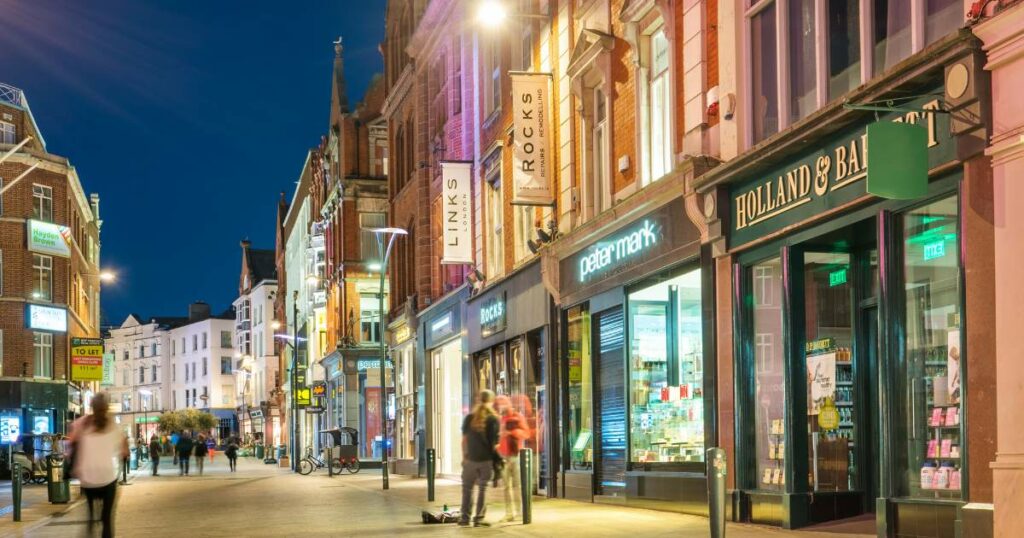
The street is lined with musicians and street performers who create a unique atmosphere, especially at weekends and during the Christmas season when the atmosphere becomes even more festive. Among the shops, you will find everything from big international brands to small local shops selling handmade products and souvenirs of the city. Plus, the theatres and pubs lining Grafton Street mean there’s always something to see or do, day or night.
In terms of history, Grafton Street has a classic Dublin feel, with Victorian buildings lining the street, making it a perfect place to stroll around and enjoy the local architecture. Highlights include the Pavilion Theatre, a major live performance venue, and Stephen’s Green Shopping Centre, a shopping centre that has become a landmark in the area.
If you are wondering things to do in Dublin, Grafton Street is definitely a place that reflects the vibrant soul of the city, a perfect meeting point for strolling, shopping, enjoying live music or simply relaxing in one of its cafes while watching the hustle and bustle of the city.
Trinity College
Trinity College is one of Dublin’s most iconic landmarks and an essential visit if you’re wondering things to do in Dublin. Founded in 1592, it is Ireland’s oldest university and one of the most prestigious educational establishments in the world. Situated in the heart of the city, on a sprawling campus surrounded by impressive Georgian buildings, Trinity College is an architectural gem that combines academic tradition with history.
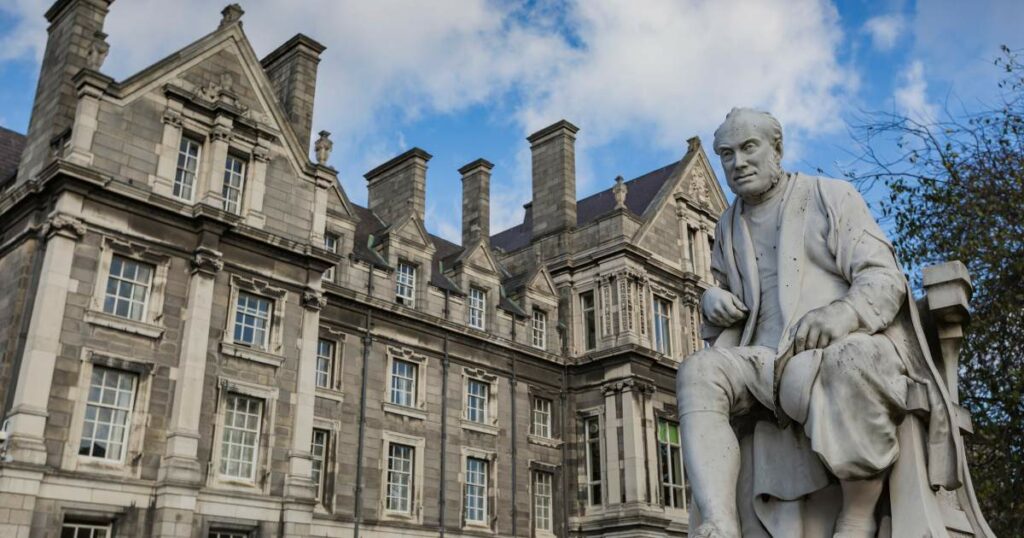
One of Trinity College ‘s main attractions is the famous Trinity College Library, home to the Book of Kells, one of the most important and best preserved medieval manuscripts. This beautifully decorated and illuminated book is a masterpiece of Celtic art and one of Ireland’s most valuable pieces. The library itself is an impressive place, with its large Long Room, whose shelves filled with ancient books create a unique atmosphere that transports visitors to another time.
In addition to the Book of Kells, Trinity College houses a wealth of historical and scientific collections. The campus is filled with beautiful gardens and squares where students and visitors enjoy a tranquil setting amidst the hustle and bustle of the city.
If you’re wondering things to do in Dublin, a visit to Trinity College is a must, both for its historical importance and for the beauty of its buildings and cultural significance. Strolling through its grounds, admiring its architecture and exploring its library is an experience that connects you directly with Ireland’s rich academic and cultural heritage. If you want to find out more, you can purchase a ticket at the following link.
National Museum of Ireland
The National Museum of Ireland is one of Dublin’s most important cultural institutions and a must-see if you’re wondering things to do in Dublin. With several venues in the city, each focusing on different aspects of Irish history, this museum offers an enriching experience for both history buffs and those curious about local culture.

One of the highlights is the National Museum of Archaeology, located on Kildare Street. Here, you can admire an impressive collection of artefacts spanning from 7000 BC to the Middle Ages. Among its most famous exhibits are the Ardagh Treasure, which includes the Ardagh Chalice, one of the most exquisite pieces of Irish art, and St Patrick’s Bell Tower, a 5th century bell. Also of note are the exceptionally well-preserved human remains of the peat bog bodies, which offer a unique insight into Iron Age burial practices.
The National Museum of Natural History, popularly known as the ‘Dead Zoo’, is located on Merrion Street. This venue houses a fascinating collection of natural specimens, including mammals, birds and reptiles. Its Victorian atmosphere and classical layout of the exhibits provide a unique experience that will transport you to another era.
If you are interested in Ireland’s social and military history, a visit to the National Museum of Decorative Arts and History in Collins Barracks is a must. In this former military barracks, objects illustrating everyday life, military uniforms, domestic history and much more are on display.
Entry to all of the National Museum of Ireland’s venues is free, allowing you to explore the country’s rich history and culture at no extra cost. If you’re wondering things to do in Dublin, the National Museum of Ireland is an essential place to go to understand Ireland’s deep and multi-faceted history.
St. Anne’s Church
St. Ann’s Church is one of the most iconic churches & things to do in Dublin, ideal for those seeking a place of peace and tradition in the city centre. Located on Dawson Street, it is an excellent example of Georgian architecture, built in 1720 by the architect Isaac Wills. Its neo-Romanesque façade was added in 1868 by architects Thomas Newenham Deane and his father, giving it a distinctive touch. The interior of the church retains original details, such as the high altar and dark wooden pews, contrasting with the soft yellow painted walls. It also houses some of Dublin’s oldest Victorian stained glass windows.
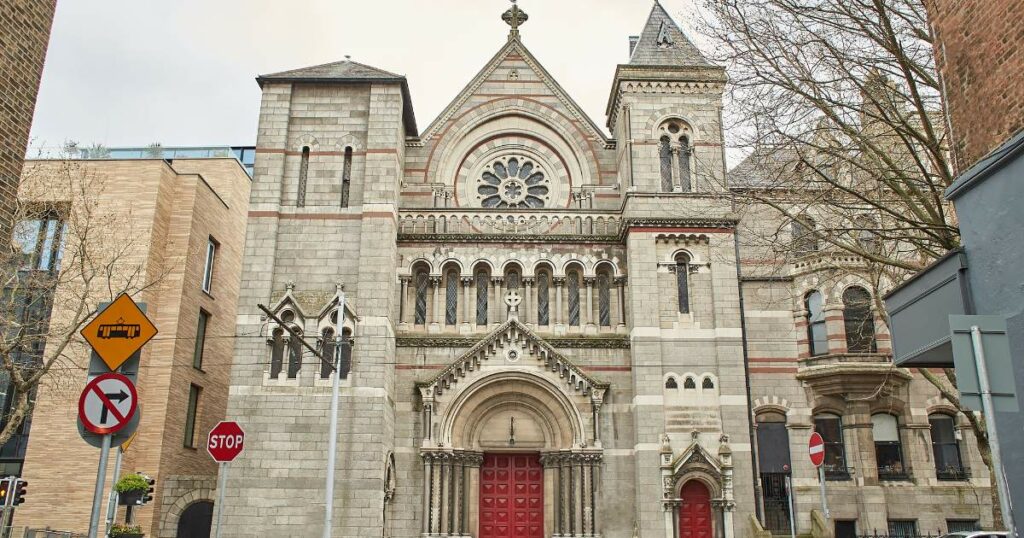
One of the most interesting aspects of St. Anne’s Church is the tradition of the Bread Shelf, a charitable initiative that began in 1723 with a donation from Lord Newton. This tradition is still alive today, with the church donating 120 loaves of bread a week to those in need, a practice that has endured for almost 300 years.
If you’re wondering things to do in Dublin, you can’t miss this historic church. It is open to the public Monday to Friday from 10am to 2pm and admission is free. It also hosts concerts and cultural events, one of the most popular being a chamber music recital on Thursdays at 13:20.
St. Anne’s Church is within easy reach of other points of interest such as Grafton Street and St. Stephen’s Green, so it’s easy to include it in your tour of the city. If you’re looking for a place of calm, history and generosity in the heart of Dublin, this church is a must-see.
Tips to travel with peace of mind
When everything is ready — flights, hotel, itinerary — there are only two more things you need to travel worry-free: a good internet connection and reliable travel insurance.
✔ Get an international eSIM already set up on your phone. No need to change your SIM card, search for Wi-Fi, or pay for roaming. Activate it before your trip and enjoy unlimited data from the very first minute, wherever you are.
✔ Take out travel insurance that includes medical assistance 24/7, coverage for cancellations, theft, and — most importantly — advance payment of all medical expenses without you having to pay, wherever you are. Because in a new country, what matters most is feeling safe. Moreover, DareMapp offers you a 5% discount.
Both services can be arranged online in less than 5 minutes, with no paperwork required.
Don’t leave it to the last minute!
👉 Activate your Holafly eSIM at the best price here.
👉 Take out your travel insurance with IATI and get a 5% discount.
We hope this guide to Dublin’s must-see attractions will help you discover the magic of the ‘City of Literature’. But if you want to experience it to the fullest, don’t miss the DareMapp app!
With it you’ll have everything in one app:
✅ Route through Saint Patrick’s Cathedral or the National Museum , among other points.
✅ Local recommendations (the best cafés, breweries and the most important dishes).
✅ Excursions and fun activities in towns near the city.
nightlife plans (bars, music clubs and much more).
Everything to see in Dublin and much more at your fingertips and from your mobile. Download it for free here!
Dublin is an open book of history, art and magic. We hope this guide of things to do in Dublin will inspire you to explore it with the eyes of a curious traveller
Remember that with DareMapp you can take a multitude of interactive guided tours, including many of these “Europe’s Most Famous Routes” for fun sightseeing at top destinations.
what better way than to travel and discover while learning in a fun way? Visit


